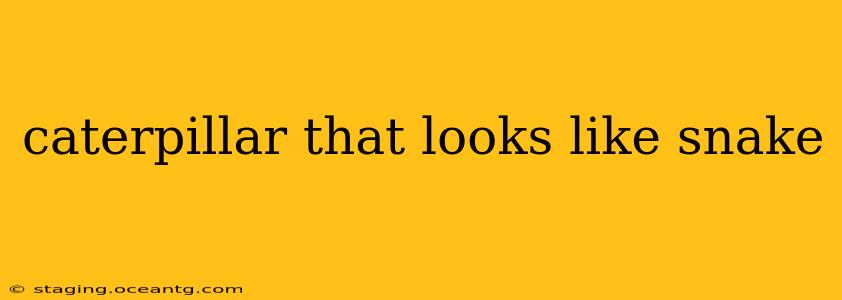Many caterpillars employ incredible camouflage to protect themselves from predators. One of the most striking examples is the caterpillar that mimics a snake. This clever disguise offers a significant advantage in the often-dangerous world of insects. But which caterpillars achieve this remarkable feat? Let's delve into the fascinating world of these deceptive creatures.
What Kind of Caterpillar Looks Like a Snake?
Several caterpillar species have evolved to resemble snakes, employing a variety of techniques to achieve this illusion. The specific appearance varies depending on the species, but common features include:
- Coloration: Many mimic the colors of venomous snakes, using shades of green, brown, black, and even bright warning colors like red or yellow. This often includes patterns that resemble snake scales or markings.
- Shape and Posture: Some caterpillars will arch their bodies into an S-shape, mimicking a coiled snake. They might even raise their heads and create a "snake-like head" by using specific body segments.
- Behavioral Mimicry: Besides their appearance, some caterpillars also engage in behavioral mimicry. They may sway their bodies back and forth to imitate a snake's movements, further enhancing the deception.
While pinpointing one specific "caterpillar that looks like a snake" is impossible without knowing the geographical location and specific visual characteristics, several families contain species known for their snake-like disguises. These include the Sphingidae (sphinx moths), some Geometridae (geometer moths), and certain Noctuidae (owlet moths) families. It's crucial to remember that this is not an exhaustive list and many other species might exhibit similar mimicry.
What is the Purpose of the Snake Mimicry?
The primary reason for this remarkable adaptation is predator avoidance. By mimicking snakes, these caterpillars deter potential predators, such as birds, lizards, and other insects. Predators are often wary of snakes, associating them with potential danger or venom. This fear response can effectively protect the unsuspecting caterpillar.
Are These Caterpillars Poisonous or Venomous?
It's crucial to understand that while many of these caterpillars mimic the appearance of venomous snakes, they are not venomous themselves. Their defense mechanism relies solely on the visual deception. They possess no fangs, venom glands, or other means of delivering venom.
How Can I Identify a Caterpillar That Looks Like a Snake?
Identifying the exact species requires careful observation and potentially consulting entomological resources or experts. Note the following:
- Location: Knowing the geographic location where you observed the caterpillar will help narrow down the possibilities.
- Color and Pattern: Take detailed notes on its colors, patterns, and markings. Photographs are invaluable for identification.
- Size and Shape: Record the caterpillar's size and body shape, including any unique features.
- Behavior: Observe its behavior, paying attention to how it moves and postures itself.
What Happens to the Caterpillar After It Becomes a Butterfly or Moth?
Once the caterpillar completes its metamorphosis, it transforms into a butterfly or moth. The adult insect usually loses the snake-like resemblance, often exhibiting entirely different colors and patterns. The camouflage is solely a survival strategy for the larval stage.
Are There Any Other Insects That Mimic Snakes?
While caterpillars are notable examples, other insects also employ snake mimicry. Several species of stick insects and even some beetles have evolved similar adaptations for protection. This demonstrates the power of natural selection and the incredible diversity of survival strategies found in the insect world.
This exploration highlights the fascinating world of insect camouflage and the incredible adaptations that help ensure survival. Remember to always approach wildlife with respect and observe from a safe distance. Further research using specific location data and visual descriptions will help in accurate species identification if you encounter a caterpillar that looks like a snake.
